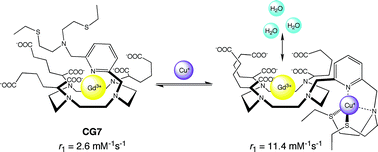We present the synthesis and characterization of Copper-Gad-7 (CG7), a new copper-activated magnetic resonance imaging (MRI) contrast agent that possesses a Gd3+–DO3A scaffold with an appended thioether-rich receptor for copper recognition. Installation of additional carboxylate groups on the periphery of the CG scaffold affords a practical strategy to increase the absolute relaxivity of these types of copper-responsive MRI sensors as well as reduce their sensitivity to biologically abundant anions. Due in large part to restricted access of inner-sphere water molecules to the paramagnetic Gd3+ core, in the absence of copper ions, CG7 exhibits a relatively low relaxivity value of r1 = 2.6 mM−1 s−1; addition of Cu+ triggers a 340% enhancement in relaxivity to r1 = 11.4 mM−1 s−1. For comparison, the relaxivity of the analogous CG2 sensor without peripheral carboxylates increases from r1 = 1.5 to 6.9 mM−1 s−1 upon Cu+ binding. CG7 features high selectivity for Cu+ over a range of biologically relevant metal ions, including the cellular abundant alkali and alkaline earth cations and d-block ions Zn2+ and Cu2+. Moreover, the Cu+-response of the CG7 sensor is not significantly affected by bicarbonate, phosphate, citrate, and lactate anions at cellular levels. 17O NMR dysprosium-induced shift (DIS) and nuclear magnetic relaxation dispersion (NMRD) experiments suggest that the origin of the improved anion compatibility of CG7 is a reduced q modulation compared to previous members of the CG family, and T1-weighted phantom images confirm that CG7 can monitor changes in copper levels by MRI at clinically relevant field strengths.

You have access to this article
 Please wait while we load your content...
Something went wrong. Try again?
Please wait while we load your content...
Something went wrong. Try again?


 Please wait while we load your content...
Please wait while we load your content...